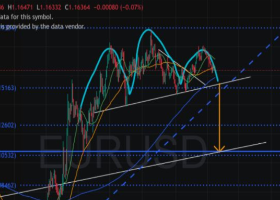The negative rate environment is having unintended consequences, one of which is the ressurection of gold.
Gold is on the rise.
The precious metal has rallied sharply from lows in the 1040s to its current rate in the 1230s - a rise of nearly 20% since only the end of last year.
Analysts at HSBC have some interesting insights into what might be driving the increased demand for gold, citing six rationale:
1. Investors seek the safe-harbour of gold when risk aversion is running high. The general uncertainty which goes with negative rates, the fear of the spiral of deflation, in itself is cause to expect an increase in demand for the metal. HSBC further add that the fact that certain central banks (the ECB aside) have not indicated a bottom-limit to negative rates, feeds speculation of even deeper cuts, leading to greater flows into gold:
“In particular, there is no sense yet that negative rates could not be cut even further. For example, Haruhiko Kuroda, the governor of the Bank of Japan, said that there is no limit to measures to ease monetary policy. The Riksbank surprised the market on 11 February with a 15bp cut, taking rates into more negative territory. Such rhetoric and action continue to feed the demand for gold.”
2. According to HSBC “risk aversion” is now in the “market psyche” and as a backdrop continues to drip feed demand for gold. In addition, the bank says the flattening US yield curve presages the possibility of an economic slow-down, as it has not been so flat since 2008, during the early stages of the financial crisis, when gold was at the start of its bull-market.
“The difference between the 2 and 10-year Treasury yields is now less than 100 basis points. The spread has not been this narrow since January 2008. A flattening yield curve often presages an economic slowdown, which may trigger policy responses that generally support gold.”
3. Negative interest rates remove the ‘opportunity cost’ of owning gold, which is the cost of owning an investment compared to owning risk-free government bonds.
4. One of the goals of negative interest rates is to penalise savers and encourage them to withdraw their money and spend it in the real economy. This effectively means moving to cash. In such a climate gold becomes a very appealing receptacle.
5. In previous periods of risk aversion gold did not perform as well as it is now. HSBC speculates this is because the dollar rose during those risk-off periods because investors preferred U.S bonds, however, this time around bonds have been passed over because of their unappealing yield potential, and gold has once again regained its previous preeminent position in the pantheon of safe-havens. As HSBC conclude: “This has important ramifications for gold going forward.”
6. Gold is an “intervention free” ‘currency. This means that there is no risk to investors of a central bank intervening to devalue it, which there might be, for example, if the investors kept their assets in CHF or JPY. The HSBC note points out that there is now a heightened risk of central banks trying ever harder stimulus methods, including direct intervention to devalue their currencies as the impact of negative rates starts to wear off.
PS: Copy signals, Trade and Earn on Forex4you - https://www.share4you.com/en/?affid=0fd9105



